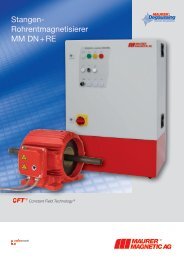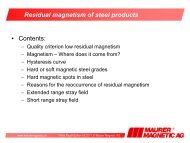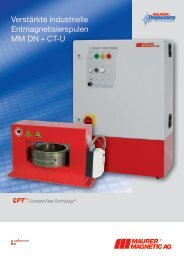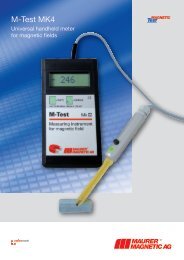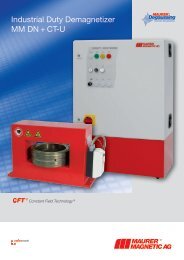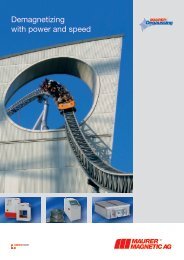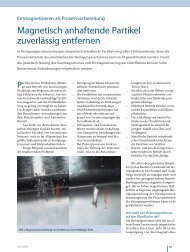D - Maurer Magnetic AG
D - Maurer Magnetic AG
D - Maurer Magnetic AG
Erfolgreiche ePaper selbst erstellen
Machen Sie aus Ihren PDF Publikationen ein blätterbares Flipbook mit unserer einzigartigen Google optimierten e-Paper Software.
Edition: 4.2010<br />
Wissenswertes über<br />
Magnetwerkstoffe<br />
Neodymium-Eisen-Bor-Magnete<br />
(NdFeB)<br />
Gegenüber SAMARIUM-KOBALT (SmCo) ist das<br />
Energieprodukt um ca. 30% höher, das spezifische<br />
Gewicht niedriger, und die mechanische<br />
Festigkeit viel besser.<br />
Die Herstellung erfolgt durch Pressen und Sintern<br />
von Rohblöcken. Aus diesen Blöcken werden mit<br />
Diamant-Trennscheiben Magnetformen «aus dem<br />
Vollen» geschnitten. Dabei können geringe Toleranzen<br />
eingehalten werden. Bei grösseren Stückzahlen<br />
ist auch die Herstellung von einfachen geometrischen<br />
Formen – Scheiben, Ringen, Quadern<br />
– durch Pressen im Werkzeug möglich. Die magnetischen<br />
Werte sind dabei 10 ... 15% niedriger.<br />
Die Koerzitivfeldstärke nimmt bei steigender<br />
Temperatur ab. Ab der materialbedingten Einsatztemperatur<br />
entstehen irreversible Verluste. Die<br />
magnetischen Werte bewegen sich bei einem Tk<br />
von +/- 0.11% pro 1°C. Mit einem kleinen Flächen-<br />
/Dickenverhältnis tritt der irreversible magnetische<br />
Verlust schon vor der angegebenen Einsatztemperatur<br />
ein.<br />
Eigenschaften<br />
Spezifisches Gewicht: 7.5 g/cm3 Druckfestigkeit: 300 N/cm2 Biegefestigkeit: 140 N/cm2 Spezifischer Widerstand: 1.5 µΩm<br />
Max. Gebrauchstemp.:<br />
Temperatur-Koeffizient<br />
80 ... 180 °C<br />
(je nach Typ)<br />
von Br: 0.11 %/°C<br />
Curie -Temperatur: 310 °C<br />
Wissenswertes über Magnetwerkstoffe<br />
Information about magnetic materials<br />
Information about magnetic<br />
materials<br />
Neodymium-Iron-Boron magnets<br />
(NdFeB)<br />
Their energy density is about 30% higher than that<br />
of SAMARIUM-COBALT (SmCo) magnets, their<br />
specific weight is lower, and their mechanical resistance<br />
much better.<br />
They are produced by compression and sintering<br />
of ingots. Magnet shapes are cut out of these<br />
ingots by means of diamond charged cutting-off<br />
wheels, thus ensuring that small cutting tolerances<br />
can be kept. Large scale manufacture<br />
also permits the production of simple geometrical<br />
shapes such as disks, rings, or square blocks,<br />
through compression in a mould. The magnetic<br />
characteristics, however, are reduced by<br />
10 ...15%.<br />
The coercitivity field density diminishes in case of<br />
rising temperature. Depending on materials used,<br />
irreversible losses are caused after the operating<br />
temperature has been reached. The magnetic values<br />
operate at a Tk of +/- 0.11% per 1°C. In case<br />
of a small surface / thickness relationship, such<br />
irreversible losses are already caused before the<br />
indicated working temperature has been reached.<br />
Characteristics<br />
Specific weight: 7.5 g/cm3 Compression resistance: 300 N/cm2 Flexional resistance: 140 N/cm2 Specific resistance: 1.5 µΩm<br />
Maximum working temperature: 80 ... 180 °C<br />
Thermal conductivity of Br :<br />
(depending on type)<br />
0.11 %/°C<br />
Curie temperature: 310 °C<br />
Tel. 044/936 60 30, Fax 044/936 60 48<br />
Industriestrasse 8, CH-8627 Grüningen www.maurermagnetic.ch<br />
52-1
Edition: 4.2010<br />
Samarium-Kobalt-Magnete (SmCo)<br />
Handelsübliche Dauermagnete der ALNICO-<br />
Gruppe und der Ferrite sind heute so ausgereift,<br />
dass eine wesentliche Steigerung ihrer magnetischen<br />
Kennwerte nicht mehr erwartet werden<br />
kann.<br />
Für besonders anspruchsvolle Aufgaben sind<br />
in jüngster Zeit neuartige Dauermagnete entwickelt<br />
worden, welche auf der Materialzusammenstellung<br />
von sogenannten «Seltenen Erden»<br />
(Sama rium, Cer, Lathan usw.) und Kobalt beruhen.<br />
Die Energiedichte dieser Dauermagnete ist<br />
um ein mehrfaches höher als diejenigen der bekannten<br />
ALNICO-oder Ferritmagnete.<br />
Im Vergleich zu den klassischen Dauermagnet-Werkstoffen<br />
bieten die SAMARIUM-KO-<br />
BALT- Magnete die hohe Flussdichte der ALNI-<br />
CO- Magnete, verbunden mit einer sehr hohen<br />
Koer zitivfeldstärke. Sie lassen sich deshalb ohne<br />
weiteres auch in entmagnetisierenden Feldern<br />
einsetzen, ohne an Magnetkraft zu verlieren.<br />
Ein typisches Beispiel ist die Verwendung als abstossender<br />
statt anziehender Dauermagnet.<br />
SAMARIUM-KOBALT-Magnete sind mechanisch<br />
hart und spröde. Für ihre Bearbeitung müssen diamantbestückte<br />
Werkzeuge eingesetzt werden.<br />
Eigenschaften<br />
Spezifisches Gewicht: 8.5 g/cm 3<br />
Druckfestigkeit: 300 N/mm 2<br />
Biegefestigkeit: 70 N/mm 2<br />
Vickershärte: 5’000 N/mm 2<br />
Elastizitätsmodul: 155’000 N/mm 2<br />
Wärmeausdehnungszahl: 5.6 ppm/°C<br />
Spezifischer Widerstand: 0.6 µΩm<br />
Wärmeleitzahl: 12 W/m°C<br />
Max. Gebrauchstemp.: 300 °C<br />
Temperatur-Koeffizient von Br: 0.04 %/°C<br />
Metallurgische Zusammensetzung<br />
SmCo5 ca. 35% Samarium, 65% Kobalt<br />
SmCo 2:17 25% Samarium, 50% Kobalt<br />
wenige Prozent Zirkom und Kupfer,<br />
Rest Eisen (FE)<br />
Curie-Temperatur: 450 °C<br />
Wissenswertes über Magnetwerkstoffe<br />
Information about magnetic materials<br />
Samarium-Cobalt Magnets(SmCo)<br />
The development of permanent magnets of the<br />
ALNICO group and the ferrites has reached such<br />
a degree of quality, so that no further, marked<br />
improvements of their magnetic characteristics<br />
can be expected.<br />
New kinds of permanent magnets, which consist<br />
of so-called «rare types of earth» (Samarium,<br />
Cer, Lanthan, etc.) and cobalt, have recently been<br />
developed to provide sophisticated solutions for<br />
particularly demanding problems. The density of<br />
energy of such magnets is highly superior to that<br />
of the well-known ALNICO or ferrite magnets.<br />
In comparison to the classical permanent magnet<br />
matters, SAMARIUM- COBALT magnets offer the<br />
high flux density of the ALNICO magnets combined<br />
with a very high coercitivity field density.<br />
Due to this characteristic, they can be employed<br />
in demagnetising fields without loss of magnetic<br />
force. Their use as repelling, instead of attracting,<br />
permanent magnets is a typical example.<br />
SAMARIUM-COBALT magnets are mechanically<br />
hard and brittle. They can only be processed with<br />
the help of diamond charged tools.<br />
Characteristics<br />
Specific weight: 8.5 g/cm3 compression resistance: 300 N/mm2 Flexional resistance: 70 N/mm2 Vickers pyramid hardness: 5’000 N/mm2 Bulk modulus of elasticity: 155’000 N/mm2 Thermal expansion: 5.6 ppm/°C<br />
Specific resistance: 0.6 µΩm<br />
Thermal conductivity:<br />
Maximum working<br />
12 W/m°C<br />
temperature: 300 °C<br />
Temperature coefficient of Br: 0.04 %/°C<br />
Metallurgical composition<br />
SmCo5 ~ 35% samarium, 65% cobalt<br />
SmCo 2:17 25% samarium, 50% cobalt<br />
small percent- ages of zircon and<br />
copper, the remaining part is iron<br />
Curie - temperature: 450 °C<br />
Tel. 044/936 60 30, Fax 044/936 60 48<br />
Industriestrasse 8, CH-8627 Grüningen www.maurermagnetic.ch<br />
52-2
Edition: 4.2010<br />
Ferrit-Magnete (HF)<br />
FERRIT-Magnete zeichnen sich durch hohe<br />
Widerstandskraft gegen entmagnetisierende Einflüsse<br />
aus. Die Kraftliniendichte ist kleiner als bei<br />
ALNICO-Magneten. Die magnetische Stabilität bei<br />
Erwärmung ist wesentlich schlechter, weshalb die<br />
max. Arbeitstemperatur höchstens 200°C beträgt.<br />
FERRIT-Magnete sind hart und spröde und lassen<br />
sich nur schleifen.<br />
Eigenschaften<br />
Spezifisches Gewicht: 4.6 ... 5.1 g/cm3 Zugfestigkeit: 50 N/mm2 Druckfestigkeit: 700 N/mm2 Härte Mohs: 6 ... 7<br />
Wärmeausdehnungszahl: 8.5 ppm/°C<br />
Spezifischer Widerstand: 10 6 Ωm<br />
Max. Gebrauchstemp: 250 °C<br />
Temperatur-Koeffizient von Br: 0.2 %/°C<br />
Chemische Zusammensetzung<br />
6Fe2O3·BaO<br />
Wissenswertes über Magnetwerkstoffe<br />
Information about magnetic materials<br />
Ferrit Magnets (HF)<br />
The main characteristic of FERRIT magnets is<br />
their high resistance against demagnetising influences.<br />
The density of power lines is smaller than<br />
that of Alnico magnets. The magnetic stability in<br />
case of warming is considerably worse, herefore<br />
maximum working temperature may be no higher<br />
than 200°C. FERRIT magnets are hard and brittle<br />
and can only be ground.<br />
Characteristics<br />
Specific weight: 4.6 ... 5.1 g/cm3 Endurance limit: 50 N/mm2 Pressure resistance : 700 N/mm2 Mohs hardness: 6 ... 7<br />
Thermal expansion: 8.5 ppm/°C<br />
Specific resistance: 10 6 Maximum working<br />
Ωm<br />
temperature:<br />
Temperature coefficient<br />
250 °C<br />
of Br: 0.2 %/°C<br />
Chemical omposition<br />
6Fe2O3·BaO<br />
Tel. 044/936 60 30, Fax 044/936 60 48<br />
Industriestrasse 8, CH-8627 Grüningen www.maurermagnetic.ch<br />
52-3
Edition: 01.2005<br />
Alnico-Magnete<br />
ALNICO-Magnete zeichnen sich durch grosse<br />
Kraftliniendichte aus. Die gute mechanische Stabilität<br />
bei Erwärmung erlaubt deren Verwendung bei<br />
Arbeitstemperaturen von bis zu 500°C. Das makrokristalline<br />
Gefüge ist verantwortlich für die Härte<br />
der ALNICO-Magnete.<br />
Beachten Sie bitte folgende Punkte:<br />
– ALNICO-Magnete können weder gesägt,<br />
gebrochen, noch gedreht werden; einzige<br />
Bearbeitungsmöglichkeit ist das Schleifen.<br />
– ALNICO-Magnete sind empfindlich gegen<br />
magnetische Einflüsse und unsachgemässes<br />
Manipulieren.<br />
– ALNICO-Magnete dürfen nur an den Polflächen<br />
mit Eisen oder anderen Magneten in Berührung<br />
gebracht werden. (Bei Magnetberührung<br />
ungleichnamige Pole aufeinander).<br />
– Niemals gleichnamige Pole aufeinander<br />
pressen.<br />
– Polschlussplatten oder sich gegenseitig<br />
kurzschliessende Magnete nicht voneinander<br />
abschieben, sondern brechen.<br />
– ALNICO-Magnete erlauben Arbeitstemperaturen<br />
bis 500°C.<br />
– Bei rot lackierten Typen ist die Farbe<br />
bis max. 120°C beständig.<br />
– Die Magnetkraft von ALNICO-Magneten<br />
wird nur schwächer, wenn eine magnetische<br />
Schädigung vorausgegangen ist. Geschädigte<br />
Magnete können durch Aufmagnetisieren ihre<br />
ursprüngliche Kraft zurückgewinnen.<br />
Eigenschaften<br />
Zugfestigkeit: wegen Neigung zu<br />
Druckfestigkeit: inneren Rissen nicht<br />
angegeben<br />
Spezifisches Gewicht : 6.9 ... 7.3 g/cm3 Wärmeausdehnungs-<br />
Koeffizient: 11 ... 14 ppm/°C<br />
Wärmeleitfähigkeit: ähnlich wie Stahl<br />
Curie-Temperatur: 700 ... 850 °C<br />
Max. Gebrauchstemperatur:<br />
450 ... 500 °C<br />
Temperatur-Koeffizient<br />
von Br: 0.02 %/°C<br />
Wissenswertes über Magnetwerkstoffe<br />
Information about magnetic materials<br />
Alnico magnets<br />
ALNICO magnets are characterised by a high<br />
density of lines of force. Their good mechanical<br />
stability in case of heating permits their use in<br />
working temperatures of up to 500°C. Their macrocristalline<br />
structure is responsible for the hardness<br />
of ALNICO magnets.<br />
Please observe the following points:<br />
– ALNICO magnets must not be cut, broken or<br />
turned; the only means of processing is grinding.<br />
– ALNICO magnets are sensitive to magnetic<br />
influences and inadequate manipulation.<br />
– ALNICO magnets may only be brought in contact<br />
with iron or other magnets on their pole<br />
surfaces. (In case of contact with a magnet, on<br />
the opposite pole).<br />
– Poles of the same denominator must never be<br />
pressed on top of each other.<br />
– Do not separate pole shielding plates or magnets<br />
which shortcircuit each other by sliding<br />
them off each other; break them off.<br />
– ALNICO magnets allow working temperatures<br />
of up to 500°C.<br />
– The paint of those varnished red is heat-resistant<br />
up to a maximum temperature of 120°C.<br />
– The magnetic force of ALNICO magnets de-<br />
creases only in case of previous magnetic de-<br />
terioration. Damaged magnets can regain their<br />
original force if they are remagnetised.<br />
Characteristics<br />
Tensile strength: not indicated be-<br />
Compression strength: cause of an inclination<br />
to interior fissures<br />
Specific weight: 6.9 ... 7.3 g/cm3 Thermal expansion<br />
coefficient: 11 ... 14 ppm/°C<br />
Thermal conductivity: similar to that of<br />
steel<br />
Curie temperature: 700 ... 850 °C<br />
Maximum working<br />
temperature: 450 ... 500 °C<br />
Temperature coefficient<br />
of Br: 0.02 %/°C<br />
Tel. 044/936 60 30, Fax 044/936 60 48<br />
Industriestrasse 8, CH-8627 Grüningen www.maurermagnetic.ch<br />
52-4
Edition: 01.2005<br />
Chemische Zusammensetzung<br />
AI 07 ... 12 %<br />
Ni 14 ... 20 %<br />
Co 16 ... 40 %<br />
Cu 03 ...0 4 %<br />
Ti 00 ... 10 %<br />
Nb 00 ... 10 %<br />
Fe Rest<br />
Die ALNICO-Legierungen sind weniger rostanfällig<br />
als normaler Stahl, jedoch nicht rost-und<br />
säurebeständig. Gegen stark alkalische Lösungen<br />
sind die ALNICO-Legierungen wegen ihres hohen<br />
Aluminiumgehaltes unbeständig. Als Rostschutz<br />
bieten sich folgende Möglichkeiten an: Einbrennlackieren,<br />
Brünieren, galvanische Veredlung (nur<br />
bei unmagnetisierten Magneten möglich).<br />
Wissenswertes über Magnetwerkstoffe<br />
Information about magnetic materials<br />
Chemical composition<br />
AI 07 ... 12 %<br />
Ni 14 ... 20 %<br />
Co 16 ... 40 %<br />
Cu 03 ... 4 %<br />
Ti 00 ... 10 %<br />
Nb 00 ... 10 %<br />
Fe remaining part<br />
ALNICO alloys are less inclined to rust than ordinary<br />
steel, however, they are not rust- and acidproof.<br />
ALNICO alloys are not resistant against<br />
strong alcaline solutions because of their high<br />
aluminium content. The following possibilities offer<br />
suitable protection against rust: stove enamel finish,<br />
burnishing, electroplating (only possible for non-magnetised<br />
magnets).<br />
Tel. 044/936 60 30, Fax 044/936 60 48<br />
Industriestrasse 8, CH-8627 Grüningen www.maurermagnetic.ch<br />
52-5
Edition: 5.2006<br />
Plastoferrit-Magnete (PF)<br />
Durch Vermischen von pulverisiertem Ferrit mit<br />
künstlichem Gummi wurde das Problem der Zerbrechlickeit<br />
der FERRIT-Magnete überwunden.<br />
PLASTOFERRIT-Magnete lassen sich als Folien<br />
und Profile herstellen. Sie sind flexibel und lassen<br />
sich mit Schere und Messer bearbeiten. Die magnetischen<br />
Eigenschaften sind jenen der FERRIT-<br />
Magnete ähnlich. Doch sind deren magnetische<br />
Werte ungefähr um zwei Drittel kleiner. Die maximale<br />
Gebrauchstemperatur beträgt ca. 80°C.<br />
Das Magnetmaterial ist auch mit einer Selbstklebeschicht<br />
verfügbar. Bei extrudierten Plasto-Ferrit-Profilen<br />
ist eine Ausrüstung mit Selbstklebebeschichtung<br />
nicht zu empfehlen. Die klebetechnisch<br />
schwierige Oberfläche gewährleistet keine optimale<br />
Haftung.<br />
Bei Magnetplatten und Folien sind die aufgebrachten<br />
Klebemassen für praktisch alle Anwendungen<br />
optimal. Die endgültigen Klebeeigenschaften<br />
sind mittels Versuchen zu prüfen.<br />
Allgemein-Toleranzen für Magnetfolien-Zuschnitte<br />
Dimension > 6 ... 30 mm = ± 0.5 mm<br />
> 30 ... 120 mm = ± 0.8 mm<br />
> 120 ... 315 mm = ± 1.2 mm<br />
> 315 ... 1000 mm = ± 2.0 mm<br />
Wissenswertes über Magnetwerkstoffe<br />
Information about magnetic materials<br />
Plasto-ferrite magnets (PF)<br />
The problem of brittleness of FERRITE magnets<br />
has been solved by mixing pulverized ferrite with<br />
synthetic rubber. PLASTOFERRITE magnets can<br />
be produced in the shape of foils and profiles;<br />
they are flexible and can be cut with scissors and<br />
knives. Their magnetic characteristics are similar<br />
to those of the FERRITE magnets. Their magnetic<br />
values, however, are approximately two thirds lower.<br />
The maximum working temperature is approximately<br />
80°C.<br />
The magnetic material is also available with selfadhesive<br />
coating. Self-adhesive coating, however,<br />
is not recommended for extruded Plasto-ferrite<br />
profiles. The surface, which causes a technically<br />
difficult gluing process, cannot guarantee optimal<br />
adhesion.<br />
The adhesive coatings of magnetic plates and<br />
foils produce optimal results for nearly every kind<br />
of application.However, tests are recommended<br />
to determine the adhesive properties of products<br />
before an application is decided upon.<br />
General tolerances for magnetic foil cut-outs<br />
Dimension > 6 ... 30 mm = ± 0.5 mm<br />
> 30 ... 120 mm = ± 0.8 mm<br />
> 120 ... 315 mm = ± 1.2 mm<br />
> 315 ... 1000 mm = ± 2.0 mm<br />
=> kleinere Toleranzen auf Anfrage => smaller tolerances on request<br />
Tel. 044/936 60 30, Fax 044/936 60 48<br />
Industriestrasse 8, CH-8627 Grüningen www.maurermagnetic.ch<br />
52-6
Edition: 4.2010<br />
Neodymium-Eisen-Bor Magnete<br />
(NdFeB) kunststoffgebunden (MQ1)<br />
Ein spezielles Verfahren erlaubt die Herstellung<br />
von Flocken aus NdFeB und deren Pressung mit<br />
Duroplasten in einfache Formen. Dank Kunststoffbindung<br />
lässt sich dieses Magnetmaterial mit<br />
allen herkömlichen Werkzeugen bearbeiten. Das<br />
Energie produkt ist trotzdem noch das Dreifache<br />
eines Standard FERRIT-Magnet. Durch die hohe<br />
Koerzitivfeldstärke und die darum hohe Beständigkeit<br />
gegen magnetische Gegenfelder eignen<br />
sich NdFeB-Magnete kunststoffgebunden als<br />
Ersatz für ALNICO.<br />
Eigenschaften<br />
Spezifisches Gewicht: 6.0 g/cm 3<br />
Spezifischer Widerstand: 180 Ωm<br />
Max Gebrauchstemp.: 120 °C<br />
Bindemittel: Epoxyharz<br />
Temperatur-Koeffizient von Br: 0.04 %/°C<br />
Samarium-Kobalt-Magnete<br />
kunststoffgebunden (SmCo p )<br />
SmCo-Magnetpulver wird mit Duroplasten in<br />
einfachen Formen verpresst. In Folge des etwas<br />
tieferen Energieprodukts wird es langsam durch<br />
den MQ1 ersetzt. Nur dünnere Platten und feine<br />
Stäbe werden weiterhin, dank feinerem Pulver,<br />
aus diesem Material hergestellt.<br />
Eigenschaften<br />
Spezifisches Gewicht: 5.1 g/cm3 Max . Gebrauchstemp.: 80 °C<br />
Wissenswertes über Magnetwerkstoffe<br />
Information about magnetic materials<br />
Plasic bonded (MQ1) Neodymium-<br />
Iron-Boron magnets (NdFeB)<br />
Special processing permits the production of flakes<br />
of NdFeB and their compression with duroplastic in<br />
simple shapes. Due to plastic bonding, this material<br />
can be processed with all kinds of traditional tools.<br />
The energy density, nevertheless, remains three times<br />
that of a standard FERRITE magnet. Because<br />
of the high intensity of coercitivity and the resulting<br />
high resistance against opposing magnetic fields,<br />
plastic-bonded NdFeB-magnets can be used as<br />
suitable replacements for ALNICO magnets.<br />
Characteristics<br />
Specific weight: 6.0 g/cm3 Specific resistance: 180 Ωm<br />
Maximum working temperatue: 120 °C<br />
Bonding material: Epoxy resin<br />
Temperature coefficient of Br: 0.04 %/°C<br />
Plastic bonded Samarium-Cobalt<br />
magnets (SmCo p)<br />
SmCo-magnet powder with duroplastic is pressed<br />
into simple shapes. Because of the slightly lower<br />
energy density it is gradually replaced by the MQ1.<br />
Fine pouder is still used to produce thin plates and<br />
slender rods from this material.<br />
Characteristics<br />
Specific weight: 5.1 g/cm3 Maximum working temperature: 80 °C<br />
Tel. 044/936 60 30, Fax 044/936 60 48<br />
Industriestrasse 8, CH-8627 Grüningen www.maurermagnetic.ch<br />
52-7
Edition: 6.2005<br />
Vergleich der Energieprodukte (BxH)<br />
max. einiger Magnetwerkstoffe<br />
1 Kunststoffgebundenes Hartferrit,<br />
anisotrop 18 kJ/m 3<br />
2 Hartferrit, gesintert, anisotrop 25 kJ/m 3<br />
3 AINiCo 45/5 36 kJ/m 3<br />
4 Kunststoffgebundenes SmCo 64 kJ/m 3<br />
5 Kunststoffgebundenes NdFeB (MQ1) 75 kJ/m 3<br />
6 Samarium-Cobalt (SmCo) 195 kJ/m 3<br />
7 Neodymium-Eisen-Bor 280 kJ/m 3<br />
Haftkraft- Angaben<br />
300<br />
280<br />
260<br />
240<br />
220<br />
200<br />
180<br />
160<br />
140<br />
120<br />
100<br />
80<br />
60<br />
40<br />
20<br />
kJ/m 3<br />
1 2 3 4 5 6 7<br />
Die im Katalog aufgeführten Haftkräfte sind Richtwerte<br />
bei Raumtemperatur 20°C.<br />
Sie gelten für den senkrechten Abzug des Magneten<br />
von einer polierten Stahlplatte(ST37) mit einer<br />
Stärke von 10mm<br />
Wissenswertes über Magnetwerkstoffe<br />
Information about magnetic materials<br />
Comparison of energy density (BxH<br />
maximum value) of some magnetic<br />
material<br />
1 Plastic-bonded hard ferrite,<br />
anisotropic 18 kJ/m 3<br />
2 Hard ferrite, sintered, anisotropic 25 kJ/m 3<br />
3 ALNiCo 45/5 36 kJ/m 3<br />
4 SmCo plastic-bonded 64 kJ/m 3<br />
5 NdFeB (MQ1) plastic-bonded 75 kJ/m 3<br />
6 Samarium-cobalt (SmCo) 195 kJ/m 3<br />
7 Neodymium-iron-boron 280 kJ/m 3<br />
Information concerning adhesive<br />
strength<br />
The adhesive strengths indicated in the catalogue<br />
are approximate / standard values at a room-temperature<br />
of 20°C. They are valid for the vertical drawing<br />
off of the magnet from a polished steel plate<br />
(ST37) of a 10 millimetre thickness.<br />
Tel. 044/936 60 30, Fax 044/936 60 48<br />
Industriestrasse 8, CH-8627 Grüningen www.maurermagnetic.ch<br />
52-8
Edition: 01.2005<br />
Korrosionsverhalten Seltenerdemagnete<br />
Seltenerdemagnete zählen zu den metallischen<br />
Werkstoffen und weisen deren entsprechende<br />
Eigenschaften auf. So oxidieren die Magnete unter<br />
anderem in feuchter Atmosphäre. Durch das<br />
Zulegieren von edleren Elementen wie z.B. Kobalt<br />
kann die Reaktion mit Wasser nahezu unterdrückt<br />
werden. Deshalb bekommen SmCo-Magnete auch<br />
unter hoher Luftfeuchtigkeit lediglich eine geringe<br />
Oberflächenoxidation.<br />
Gesinterte NdFeB-Magnete weisen in der Gefügestruktur<br />
neben dem gebundenem auch freies<br />
Neodym auf. Wie fast alle Seltenerdemetalle ist<br />
diese in freier Form extrem korrosionsanfällig und<br />
bildet spontan Neodymoxid oder -hydoxid. NdFeB-<br />
Magnete werden bereits bei der Einwirkung von<br />
Luftfeuchtigkeit, Betauung oder Handschweiss<br />
angegriffen und reagieren auch durch Salze und<br />
Säuren extrem stark korrodierend. Hier lässt sich<br />
durch eine entsprechende Beschichtung eine höhere<br />
Beständigkeit erreichen.<br />
Bei den neusten Generationen der Neodymmagnete<br />
haben die Materialien N45 und N48 das<br />
beste Korrosionsverhalten gezeigt. Allerdings wird<br />
auch hier eine Beschichtung empfohlen.<br />
Kleben von Seltenerdemagneten<br />
Viele Magnete werden bei der Weiterverarbeitung<br />
klebetechnisch fixiert. Beim Kleben sind neben<br />
den Materialeigenschaften auch Beanspruchungsformen<br />
und äusserliche Beeinflussungen<br />
zu beachten. Aus diesem Grund empfehlen wir<br />
Ihnen, sich von Ihrem Kleberlieferanten beraten zu<br />
lassen.<br />
Unsere Erfahrung hat gezeigt, dass speziell beim<br />
Neodymmagneten säurehaltige Klebstoffe nicht<br />
eingesetzt werden dürfen. Diese Kleber können<br />
an der Grenzfläche zu einer raschen Zersetzungsreaktion<br />
des Magnetwerkstoffes führen. Wobei<br />
dieser Prozess auch bei beschichteten Magneten<br />
auftreten kann und durch Feuchtigkeit zusätzlich<br />
verstärkt wird.<br />
Wissenswertes über Magnetwerkstoffe<br />
Information about magnetic materials<br />
The corrosion stability of rare earths<br />
magnets<br />
Rare earths magnets are classed with the metallic<br />
materials and therefore, they show the typical properties<br />
of these materials. This means, for example,<br />
that magnets oxidise when they are exposed to a<br />
humid atmosphere. However, by means of the adding<br />
by alloying of more precious elements, such as<br />
for example cobalt, the reaction with water can be<br />
virtually allayed. Therefore, SmCo-magnets acquire<br />
only a slight oxidisation of the surface, even when<br />
exposed to high levels of air humidity.<br />
Sintered NdFeB-magnets contain, apart from the<br />
fixed, also free neodymium as part of their structure.<br />
As is the case with the majority of rare earths<br />
metals, this is in its free form extremely prone to<br />
corrosion and spontaneously forms neodymium<br />
oxide or neodymium hyoxide. NdFeB-magnets<br />
may even be attacked as a result of exposure to<br />
air humidity, dew or the perspiration of the hands,<br />
and show extremely strong reactions of corrosion<br />
when they are in contact with salts and acids. Higher<br />
levels of resistance to such influences can be<br />
achieved by appropriate coating.<br />
Of the latest generations of neodymium magnets,<br />
the materials N45 and N48 have produced the<br />
best corrosion stability.<br />
However, appropriate coating remains highly recommended,<br />
even for these magnet materials.<br />
The adhering process of rare earths<br />
magnets<br />
Many magnets are fixed by means of an adhesive<br />
technique when further processed. Apart from<br />
properties of material and kinds of use, possible<br />
external influences also have to be considered in<br />
this adhering process. Because of this reason, we<br />
recommend specific counselling by your adhesive<br />
supplier.<br />
Experience has taught us that, particularly in the<br />
case of neodymium magnets, acidic adhesives<br />
must not be employed. Such adhesives may cause<br />
a rapid erosive reaction on the fringe surface<br />
of the magnetic material. This phenomenon may,<br />
however, also occur when coated magnets are<br />
employed, moreover, the process may be further<br />
enhanced by humidity.<br />
Tel. 044/936 60 30, Fax 044/936 60 48<br />
Industriestrasse 8, CH-8627 Grüningen www.maurermagnetic.ch<br />
52-9
Edition: 01.2005<br />
Unterschiede zwischen Haft- und<br />
Zugmagneten<br />
Haftmagnete haben die Aufgabe, Gegenstände zu<br />
halten, welche an sie angelegt werden. Sie brauchen<br />
also keine grosse Tiefenwirkung zu haben.<br />
Zugmagnete dagegen müssen Gegenstände aus<br />
einer gewissen Distanz anziehen, und dies setzt<br />
eine entsprechende Tiefenwirkung voraus.<br />
Gute Haftkraft wird am besten mit nahe beieinanderliegenden<br />
Polen erreicht. Zugmagnete dagegen<br />
verlangen weit auseinanderliegende Pole.<br />
Daraus kann gefolgert werden, dass die Distanz<br />
zwischen den beiden Polen ungefähr der verlangten<br />
Tiefenwirkung des Magneten entsprechen<br />
sollte. Je grösser die Tiefenwirkung des Magneten,<br />
desto grösser der Abstand zwischen den<br />
Polen.<br />
Es ist wichtig zu wissen, dass die magnetische<br />
Anziehungskraft nicht allein vom Magnet abhängig<br />
ist. Ebenso wichtig ist der anzuziehende Gegenstand<br />
und dessen Dicke.<br />
System-Magnete<br />
SYSTEM-Magnete bestehen aus Magnetmaterial<br />
und Eisenleitstücken. Die Verwendung von Eisenleitstücken<br />
hat viele Vorteile, deren Wichtigkeit<br />
nachstehend aufgeführt ist:<br />
1. Eisen lässt eine höhere Kraftliniendichte zu als<br />
Dauermagnetwerkstoff. Dies äussert sich z.B. in<br />
höherer Hubkraft.<br />
2. Eisen lässt sich im Gegensatz zu FERRIT- und<br />
ALNICO-Magneten leicht bearbeiten.<br />
3. Die Kraftlinien lassen sich in Eisen umlenken<br />
und konzentrieren.<br />
4. Magnetwerkstoffe lassen sich besser ausnützen.<br />
5. Magnetkonstruktionen werden einfacher und<br />
billiger.<br />
Die magnetischen Eigenschaften und die max.<br />
Gebrauchstemperaturen der SYSTEM-Magnete<br />
richten sich nach den verwendeten Werkstoffen.<br />
Wissenswertes über Magnetwerkstoffe<br />
Information about magnetic materials<br />
Differences between gripping and<br />
tractive magnets<br />
The function of gripping magnets is to firmly hold<br />
objects placed against them. They need not have<br />
a great throwing power. Tractive magnets, on the<br />
other hand, must draw objects from a distance<br />
and must have great throwing power .<br />
A good grip is best achieved with a small gap<br />
between the poles. Tractive magnets, on the other<br />
hand, require widely-spaced poles. In conclusion,<br />
it can be argued that the distance between the<br />
poles should be approximately that of the required<br />
throwing power of the magnet. The greater the<br />
throwing power of the magnet, the farther apart st<br />
the magnet poles must be.<br />
It is important to know that the magnetic attraction<br />
is not determined by the magnet alone. The object<br />
to be attracted and its thickness is equally important.<br />
System magnets<br />
System magnets consist of magnetic material<br />
and pieces of conductive iron. The use of pieces<br />
of conductive iron has numerous advantages, the<br />
importance of which is listed below:<br />
1. Iron permits a higher density of lines of force<br />
than permanent magnetic matter. This can be<br />
observed e.g. in a superior lifting power,<br />
2. Iron, in contrast to FERRITE and ALNICO<br />
magnets, can be processed more easily.<br />
3. The lines of force in iron can be deviated and<br />
concentrated.<br />
4. <strong>Magnetic</strong> materials can be more efficiently ex-<br />
ploited.<br />
5. <strong>Magnetic</strong> constructions tend to become sim-<br />
pler and less expensive.<br />
The magnetic characteristics and the maximum<br />
working temperatures of SYSTEM magnets depend<br />
on the materials used.<br />
Tel. 044/936 60 30, Fax 044/936 60 48<br />
Industriestrasse 8, CH-8627 Grüningen www.maurermagnetic.ch 52-10
Edition: 01.2005<br />
Stabilität gegen Fremdfelder<br />
Auf dieselbe Weise wie jeder Magnet mit einem<br />
genügend starken, der Magnetisierung entgegengesetzten<br />
Feld entmagnetisiert werden<br />
kann, schwächt jedes entmagnetisierende Feld<br />
einen Magnet bis zu einem gewissen Punkt. Die<br />
Leistung eines frisch aufmagnetisierten Magneten<br />
wird das erste Mal einer entmagnetisierenden<br />
Kraft ausgesetzt, wenn er aus der Magnetisiervorrichtung<br />
herausgenommen wird. Das Einfügen<br />
eines Luftspaltes in einen magnetischen Kreis ist<br />
einer entmagnetisierenden Kraft gleichzusetzen.<br />
Die Induktion fällt dabei auf einen tieferen Wert,<br />
und der Magnet ist damit gleichzeitig auf diesem<br />
Wert stabilisiert. Dies ist der Zustand von aufmagnetisiert<br />
gelieferten Magneten, welcher so<br />
bleibt, bis eine stärkere entmagnetisierende Kraft<br />
sie weiter schwächt, und diese auf einem entsprechend<br />
tieferen Niveau wieder stabilisiert und so<br />
fort.<br />
Eine einfache Methode, um die Entmagnetisierung<br />
von Magneten zu verhindern oder sie zu stabilisieren,<br />
ist folglich, die vollmagnetisierten Magnete<br />
einem etwas stärkeren Gegenfeld auszusetzen,<br />
als demjenigen, dem sie später im Betrieb ausgestzt<br />
sein werden.<br />
Toleranzen<br />
Sehr oft werden bei allen Abmessungen Toleranzen<br />
angegeben, gleichgültig, ob diese erforderlich<br />
sind oder nicht. Dies rührt vermutlich daher,<br />
dass einfach die bei den übrigen Werkstücken<br />
üblichen Toleranzen übernommen werden.<br />
Es ist falsch, aus Prinzip für alle Abmessungen<br />
von Dauermagneten Toleranzen anzugeben. Es<br />
ist richtig, vorzuschreiben «wie gegossen» oder<br />
«wie gesintert», wo dies erlaubt werden kann. Die<br />
Kontrolle kostet immer Geld, auch dann, wenn<br />
zum Einhalten der Toleranzen die Magnete nicht<br />
geschliffen werden müssen.<br />
Bei der Eingangskontrolle vieler Verbraucher<br />
werden nur die Masshaltigkeit und die Oberflächenqualität<br />
geprüft. Die wichtigste Kontrolle<br />
aber, das Prüfen der magnetischen Leistung,<br />
wird unterlassen. Magnete mit Fehlern in der<br />
Oberfläche und kleinen Rissen werden zurückgewiesen,<br />
weil fälschlich angenommen wird, dass<br />
dies die magnetische Leistung vermindert.<br />
Fehler in der Oberfläche und kleinere Risse haben<br />
keinen Einfluss auf die magnetische Leistung. Das<br />
Akzeptieren von solchen Fehlern reduziert den<br />
Ausschuss und damit den Preis.<br />
Wissenswertes über Magnetwerkstoffe<br />
Information about magnetic materials<br />
Stability against external magnetic<br />
fields<br />
In the same way as every magnet can be demagnetised<br />
by a sufficiently strong field opposed to<br />
magnetisation, every demagnetised field weakens<br />
the magnet up to a certain point. The performance<br />
of a newly remagnetised magnet is subject to a<br />
demagnetising force for the first time when taken<br />
out of the magnetising device. The insertion of an<br />
air gap in a magnetic circuit is equivalent to a demagnetising<br />
force. It causes induction to decrease<br />
to a lower value, and simultaneously stabilises the<br />
magnet at this value. This is the case of magnets<br />
delivered in a magnetised state, which remains<br />
until a stronger demagnetising force further weakens<br />
the magnet, stabilises at a lower value, and<br />
so forth.<br />
A simple method to avoid demagnetisation, or to<br />
stabilise magnets is, therefore, to expose the fully<br />
magnetised magnets to an opposing magnetic<br />
field which is slightly stronger than the one they<br />
are later subjected to under working conditions.<br />
Tolerances<br />
Tolerances are very often indicated for measurments,<br />
irrespective of whether they are necessary<br />
or not. The reason for this probably stems from the<br />
fact that the tolerances indicated for other work<br />
pieces are simply taken over.<br />
It is wrong, however, to indicate tolerances<br />
in principle for all measurments of permanent<br />
magnets. It is, however, correct to prescribe<br />
tolerances for «casting» or «sintering», wherever<br />
this is possible. Checking always costs money ,<br />
even if it is not necessary to grind the magnets to<br />
keep the tolerances.<br />
The entry check of many users consists only of<br />
dimension and quality of surface. The most important<br />
check, however, the one concerning magnetic<br />
performance, is often neglected. Magnets with<br />
irregularities of surface or small fissures are rejected,<br />
because it is mistakenly supposed that this<br />
diminishes the magnetic performance.<br />
Defectiveness of surface and small fissures do not<br />
influence the magnetic performance in any way. To<br />
accept such irregularities reduces the number of<br />
rejects and consequently the price.<br />
Tel. 044/936 60 30, Fax 044/936 60 48<br />
Industriestrasse 8, CH-8627 Grüningen www.maurermagnetic.ch 52-11
Edition: 1.2009<br />
Magnetdimensionierung mit Hilfe<br />
der Entmangetisierungskurven<br />
Magnete können nicht wie andere Konstruktionsteile<br />
beliebig konstruiert oder festgelegt werden.<br />
Die Dimensionierung von Polfläche zu Länge in<br />
Magnetisierungsrichtung muss den verlangten<br />
magnetischen Werten entsprechen.<br />
Die höchste magnetische Energie ist dann vorhanden,<br />
wenn das Produkt von Remanenz B und<br />
der Koerzitivfeldstärke H ein Maximum erreicht.<br />
Das ist der Fall, wenn sich unter der Entmagnetisierungskennlinie<br />
von B zu H das grösstmöglichste<br />
Rechteck bildet (siehe Bild).<br />
Das nachstehende Diagramm hat am Rand eine<br />
Skala für das Verhältnis von der Länge zum<br />
Durchmesser eines Magneten (L/D-Verhältnis).<br />
Bei einer Magnetscheibe von Ø10 mm x 5 mm<br />
Dicke ist das L/D-Verhältnis 5:10 = 0.5. Zieht man<br />
von der 0.5 Marke eine Linie zum Nullpunkt, so<br />
ist der Schnittpunkt auf der Kennlinie des entsprechenden<br />
Magnetwerkstoffes der Arbeitspunkt<br />
(BxH) dieser Magnetscheibe.<br />
Verbindet man diesen gefundenen Arbeitspunkt<br />
waagrecht mit der B-Achse und senkrecht mit<br />
der H-Achse, kann man die Remanenz und die<br />
Koerzitivfeldstärke ablesen.<br />
Haben B und H die grösstmöglichsten Werte, liegt<br />
der Arbeitspunkt im (BxH) max.-Wert.<br />
Bei einem «offenen» Magnet, der ohne Eisenrückschluss<br />
oder Eisenpole verwendet wird, sollte die<br />
Dimensionierung so gewählt werden, dass der<br />
Arbeitspunkt in der Nähe des (BxH) max.-Wertes<br />
liegt.<br />
Bei quadratischen oder nahezu quadratischen<br />
Magnetpolflächen kann die Polfläche nach der<br />
Formel umgerechnet werden.<br />
D=<br />
D=<br />
oder<br />
a x b x 4<br />
p<br />
A · 4<br />
p<br />
Wissenswertes über Magnetwerkstoffe<br />
Information about magnetic materials<br />
Dimensioning of magnets with the help<br />
of the demagnetisation curve<br />
Magnets cannot, as other construction parts, be<br />
constructed or defined at random. The dimensioning<br />
of pole face respective to length in direction<br />
of magnetisation must correspond with the<br />
required magnetic values.<br />
The maximum magnetic energy is obtained if the<br />
product of remanence B and the coercive field intensity<br />
H attain a maximum. This is the case if the<br />
largest possible rectangle can be formed under<br />
the demagnetisation characteristic curve of B to H<br />
(see graph).<br />
The diagram below contains, in its margin, a scale<br />
indicating the relationship of the length to the diameter<br />
of a magnet (relationship L/D).<br />
For a magnetic disk of 10 mm in diameter x 5 mm<br />
thickness, the L/D relationship is equal to 5:10 =<br />
0.5. If a line is drawn from mark 0.5 to the zero<br />
point, the intersection on the characteristic curve<br />
of the corresponding magnetic material is the operating<br />
point (BxH) of this magnetic disk.<br />
If this operating point is horizontally connected<br />
with the B axis and vertically with the H axis, the<br />
remanence and the coercive field intensity can be<br />
read.<br />
If B and H have the largest possible values, the<br />
operating point is situated in the (BxH) maximum<br />
value.<br />
For an «open» magnet, which is used without<br />
steel-pole plate, or iron poles, the dimensioning<br />
should be chosen in such a manner that the operating<br />
point is situated in the proximity of the maximum<br />
value (BxH).<br />
For square or almost square magnetic pole faces,<br />
the pole face can be converted according to the<br />
following formula.<br />
The curves, indicated below, for the different ma-<br />
D=<br />
D=<br />
a x b x 4<br />
p<br />
A · 4<br />
p<br />
Tel. 044/936 60 30, Fax 044/936 60 48<br />
Industriestrasse 8, CH-8627 Grüningen www.maurermagnetic.ch 52-12<br />
ou
Edition: 01.2005<br />
Die nachstehenden Kurven für die verschiedenen<br />
Magnetwerkstoffe sind vereinfacht und<br />
ohne Temperaturcharakteristik dargestellt. Eine<br />
Temperaturänderung bewirkt eine Verschiebung<br />
des Arbeitspunktes auf der Kennlinie. Solange der<br />
Arbeitpunkt im linearen Bereich der Entmag-netisierungskennlinie<br />
bleibt, ändert sich die Induktion<br />
reversibel, d.h. nach Abkühlung kehrt der ursprüngliche<br />
Wert zurück. Andernfalls ist die Änderung der<br />
Induktion irreversibel und kann nur durch erneutes<br />
Aufmagnetisieren rückgängig gemacht werden.<br />
[ kA / m ]<br />
Entmagnetisierendes Feld (H) kA/m (KAx12.56 = Oerstedt)<br />
Demagnetising field (H) kA/m (KAx12,56 = Oerstedt)<br />
Wissenswertes über Magnetwerkstoffe<br />
Information about magnetic materials<br />
gnetic mterials are simplified and represented<br />
without temperature characteristics. A difference<br />
in temparature causes a shift of the operating<br />
point on the characteristic curve. As long as the<br />
operating point remains in the linear range of the<br />
demagnetising characteristic curve, the induction<br />
alters reversibly, i.e. after cooling off, it reverts to<br />
the original value. Otherwise, the alteration of the<br />
induction remains irreversible and can only be reversed<br />
by means of renewed remagnetisation.<br />
Tel. 044/936 60 30, Fax 044/936 60 48<br />
Industriestrasse 8, CH-8627 Grüningen www.maurermagnetic.ch 52-13<br />
[ T ]<br />
Remanenz (B) Tesla (1T = 10'000 Gauss)<br />
Remanence (B) Tesla (1T = 10'000 Gauss)



